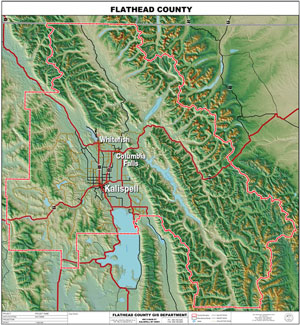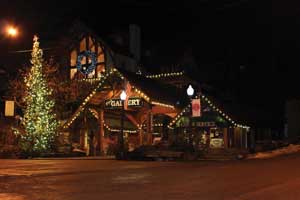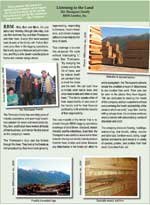3.2 TOWN PROFILES
The major cities and towns of the Flathead Watershed are located in Flathead and Lake County. Unfortunately, it is not possible in this venue to discuss all of the towns that make up the watershed, even though each one contributed to the history and growth of the area.
Flathead County
Bigfork | Columbia Falls | Kalispell | Whitefish |
Flathead County has the distinction of being home to Glacier National Park, the Bob Marshall Wilderness, the northern portion of Flathead Lake, numerous national and state forest lands, and two ski areas—Whitefish Mountain Resort and Blacktail Mountain Ski Area. With its snow-capped peaks, alpine lakes, lush forests, bountiful opportunities to view wildlife, and world-class recreational opportunities, it is easy to understand why Flathead is the fourth most populous county in Montana with an estimated 89,624 residents as of 2009. It is also one of the fastest growing counties in the state, with an estimated population increase of 20% from 2000 to 2009. Long-time residents are greatly outnumbered by new residents who tend to be middle-aged professionals and retirees.
A variety of wild berries, fruit orchards, wineries, breweries, and eateries to delight diverse tastes are found throughout the county. Rich fertile soils make the county popular for varied farming and horticultural endeavors. Flathead County encompasses 5,098 square miles (13,204 km2) or 3,262,720 acres (1,320,376 hectares) of land. With over 80% of the county’s acreage protected through national parks, federal and stateforests, and private timber reserves, the area maintains an environment rich in natural beauty. The county has one of the most diverse economies in the Rocky Mountain West with a number of stable major employers. The beauty and healthy lifestyle make Flathead County one of the most desirable areas in North America. |
 |
|
| (click to enlarge) Figure 3.17: Map of Flathead County. Source: Flathead County |
Bigfork
Bigfork (![]() in Salish), an ancient Pend d’Oreille site, was platted in 1901 by Everit Sliter. Although stories vary, it is commonly thought that Bigfork was named as a result of its location at the big fork where the Swan River enters Flathead Lake. Sliter was instrumental in the early development of the community, running the town’s first hotel and general store, serving as postmaster, and planting one of the first orchards. During the era of lake steamers, Bigfork Bay served as a harbor for the large boats. The construction of the dam, power plant, and road along the Swan River in the 1900s brought construction laborers and logging, ensuring the establishment of the village.
in Salish), an ancient Pend d’Oreille site, was platted in 1901 by Everit Sliter. Although stories vary, it is commonly thought that Bigfork was named as a result of its location at the big fork where the Swan River enters Flathead Lake. Sliter was instrumental in the early development of the community, running the town’s first hotel and general store, serving as postmaster, and planting one of the first orchards. During the era of lake steamers, Bigfork Bay served as a harbor for the large boats. The construction of the dam, power plant, and road along the Swan River in the 1900s brought construction laborers and logging, ensuring the establishment of the village.
 |
| Figure 3.18: Bigfork Village at the holidays. Source: Lori Curtis |
Now the home of the 27-hole Eagle Bend Golf Course developed with the design assistance of Jack Nicklaus, the profile of Bigfork has changed. The course is considered one of the most beautiful and challenging in the U.S. In addition to a plethora of recreational opportunities, the quaint mountain town offers unique shops and boutiques, live theater at the Bigfork Summer Playhouse, gourmet and eclectic dining, and world-class art galleries.
Once the old highway to the Swan Valley, the Swan River Nature Trail follows the rushing whitewater of the Swan River—the site of the annual Wild Mile kayak race—east out of Bigfork. The trail passes the Bigfork Dam, ending at the Kearney Rapids Bridge at Swan River Road, and is used by hikers, horseback riders, bikers, and Nordic skiers.
Columbia Falls
Where are the falls? There are a few versions of the story of how Columbia Falls got its name, but it has little to do with a waterfall. It seems by the most common popular explanation given, that the town—originally named ![]() in Salish—was called Columbus, but was renamed so as to avoid confusion with another town called Columbus near Billings. Margaret Kennedy, wife of the first postmaster chose the name Columbia because of the town’s proximity to the headwaters of the Columbia River. Falls was added to create a distinction from Columbus.
in Salish—was called Columbus, but was renamed so as to avoid confusion with another town called Columbus near Billings. Margaret Kennedy, wife of the first postmaster chose the name Columbia because of the town’s proximity to the headwaters of the Columbia River. Falls was added to create a distinction from Columbus.
The land for the town was purchased from a Tribal woman by a Butte company under the assumption that the Great Northern Railroad division station would be located there. Before the railroad reached the town, a bridge was built across the Flathead River, and a flour mill, a bank, and the Gaylord Hotel were all constructed. However, the town of Kalispell—not Columbia Falls—eventually became the first railroad division point in the area.
Logging developed early around Columbia Falls, followed by a brief period of mining when coal was discovered in the North Fork region. The first newspaper, The Columbian, was started in 1891 by J.W. Pace who had worked for The Missoulian. In 1946, Mel Ruder began publishing the Hungry Horse News which became known nationally for its coverage of Columbia Falls and Glacier National Park. Ruder went on to win a Pulitzer Prize for his coverage of the 1964 flood. Four large lumber mills established themselves in Columbia Falls, Plum Creek, Stoltze Land and Lumber, Superior Building Company, and Rocky Mountain Lumber Company. The Anaconda Aluminum Plant was completed in 1955.
Today, Columbia Falls has over 5,000 residents and remains the home of Plum Creek, Stoltze Land and Lumber, Montana Forest Products, and the small niche RBM Lumber Company. Nestled in the northeast corner of the Flathead Watershed, the city is a convenient gateway to Glacier National Park. In addition to its close proximity by highway to the western entrance to the park, it is also a pathway to a rustic and scenic alternative route to the Camas Creek Park entrance. Columbia Falls offers many antiques shopping opportunities, hiking, golf, snowmobiling, and outdoor concerts at Marantette Park.
While Columbia Falls has a number of businesses, services, and diverse dining, it is also conveniently located close to Kalispell and Whitefish. The City of Columbia Falls maintains 28 acres (11 hectares) of park land within its borders including sports fields, picnic areas, playgrounds, an aquatic center, and a water theme park. The House of Mystery—Montana’s only natural vortex (a gravitational anomaly)—invites visitors to experience unusual gravitational energies and phenomena. The three forks of the Flathead River are part of the Nation’s Wild and Scenic River System and all are accessible from Columbia Falls.
Kalispell
Founded in 1887 as Demersville, Kalispell (from the Salish word Qĺispé) became a city in 1891, just prior to the first railroad car arriving on Main Street on New Year’s Day, 1892. The railroad brought homesteaders, business owners, and tourists, and the city boomed into a commercial center including farming, flour milling, lumber milling, and engineering. Kalispell serves as the county seat and is the largest of the three incorporated cities in the county with a population of over 22,000. Greater Kalispell, which includes the outlying areas surrounding Kalispell, is home to over 40,000 people.
Kalispell is the seventh largest city in the state. The city now boasts a generally dynamic economy balanced by education, government, health services, forest products, manufacturing, engineering, retail, and tourism. Commercial development on the north side of the city in recent years has brought three-quarters of a million square feet of retail and restaurant development to support the area’s expanding population.
With an international airport, the attractions of nearby Glacier National Park, and a variety of year-round recreation, Kalispell enjoys a vigorous tourism business. Reasonable taxes, accessible transportation, advanced telecommunications technologies, numerous business services, and competitive utilities all make Kalispell an attractive location for businesses. Small businesses and entrepreneurship are encouraged and supported by local agencies and economic development programs.
 |
| Figure 3.19: Kalispell schoolhouse. Source: Flathead First |
There are a number of public and private elementary schools focusing on pre-kindergarten through grade five in the city. Kalispell Middle School supports grades six through eight. Kalispell has two high schools. Flathead High School is the first high school in the state with accreditation under the International Baccalaureate Diploma Programme to offer a two-year college preparatory curriculum for juniors and seniors. Glacier High School opened in 2007, offering a number of features including science and computer labs and a performance hall. Both schools create teams of students and teachers to focus on post high-school planning. Students find award-winning vocational agriculture and engineering, music, and drama classes, and excellent speech and debate teams at the two schools.
 |
| Figure 3.20: Flathead Valley Community College campus. Source: Flathead Valley Community College |
Flathead Valley Community College is the fifth largest public college in Montana, serving over 10,000 students annually. The college is fully accredited by the Northwest Association of Schools and Colleges and offers Associate of Science, Associate of Arts, Associate of Applied Science, certificate programs, and four-year degree partnerships with Montana State University in Billings, the University of Great Falls, and the University of Montana in Missoula. Over 50% of the college’s graduates go on to pursue advanced degrees. With 40 occupational programs and 30 transfer programs, students enjoy a 95% placement rate for jobs throughout the watershed in Flathead and Lake counties. A source of community pride, the college maintains a talented and diverse faculty, 30% with doctoral degrees.
The Flathead Watershed has come a long way since the first schoolhouse was built in 1884 by two valley homesteaders. The 14 x 16 foot (4.27 x 4.87 m) log building had a roof of split rails covered in slough grass and mud. It had two windows and a door, rough boards over pegs for seating, and no desks. A pineboard covered with sooty lampblack served as the chalkboard.
Kalispell Regional Medical Center (KRMC) meets the preventative, acute, and rehabilitative care needs of patients throughout the Flathead Watershed and beyond. The facility offers excellent diagnostic and imaging technology, and the Radiation Oncology Cancer Center features Image-Guided Radiation Therapy (IGRT). HealthCenter Northwest offers a leading-edge diagnostic hub including a full suite of imaging services, acute care beds and in-patient rehabilitation beds. The open-heart surgery program partners with the International Heart Institute of Montana in Missoula to provide the latest technologies and surgeries for cardiac patients. Two orthopedic centers serve the community with world-class orthopedic services for the diagnosis and treatment of musculoskeletal problems from fracture care to total joint replacement.
There are a number of museums, art studios and galleries, music events and festivals throughout Kalispell, including the Glacier Symphony and 75-voice Chorale, and Northwest Montana’s premier art gallery, the Hockaday Museum of Art. The Museum at Central School offers the story of Kalispell from its founding, and one of the most extensive collections of Indian artifacts, paintings, and photography in the northwest. The museum also includes histories of the logging industry and the U.S. Forest Service.
Whitefish
Although the story is not definitive, some historians believe that in the 1850s trappers working in the area noticed Native Americans catching whitefish from the lake, and named it Whitefish Lake. The Salish called it , which literally means “has whitefish.” Homesteaders came to Whitefish in the 1880s and logging activity expanded in the 1890s, but the town was not surveyed and dedicated until June of 1903. Railroad businessman James J. Hill evenutally movedt the railroad division point from Kalispell to the base of Whitefish Lake where there was a flat piece of land—though covered with virgin forest—and plenty of water.
 |
Figure 3.21: Whitefish train depot. Source: Whitefish Chamber of Commerce |
Land was acquired, rail yards constructed, timber cleared, and a small town platted. To make room for the town in the heavily wooded area, a large number of trees had to be cut. The stumps left behind created traffic issues and made construction very difficult. They also earned the town the nickname “Stumptown.” The stumps were eventually and painstakingly removed, but the nickname lives on in the names of local businesses, locally-made products, and specialty menu items.
The railroad division was completed in 1904 and the first passenger train arrived on October 4th. The town was incorporated and held its first town meeting in 1905. The railroad, timber, and farming made up the economic foundation of Whitefish for its first 50 years. A golf course with a clubhouse and airstrip followed and by the 1990s the 36-hole Whitefish Golf Course spanned land that crossed the highway with the largest golf course in Montana at the time. With the discovery of the joys of skiing in 1934, adventuresome people would hike up Hellroaring Mountain north of Whitefish and ski down. By 1947 a ski lift was built that eventually became Big Mountain and the Whitefish Mountain Resort we know today. While its importance as a railroad and timber community waned, its appeal as a recreation and retirement community gained international attention. Today Whitefish has a population of over 7,000.
The flood of new, often wealthy arrivals and visitors to Whitefish has changed the town dramatically. The cost of living in Whitefish has soared with this influx of people, many who have come to build luxury homes in the beautiful ski town. But visitors to Whitefish pay a resort tax that contributes to the maintenance of roads, the expansion of parks, and the reduction of property taxes to homeowners.
The Whitefish School District offers kindergarten through 12th grade academic studies as well as instruction in art, music, physical education, and a variety of vocational training programs. Whitefish has three schools providing preschool education: the Whitefish Christian Academy that also serves children through grade 8, Muldown Elementary School serving kindergarten through grade 4, and Whitefish Middle School serving grades 5 through 8. Whitefish has two high schools, Whitefish High School covering grades 9 through 12 and Whitefish Independent High School covering grades 10 through 12.
In addition to its close access to Kalispell medical facilities, Whitefish has been served by North Valley Hospital for over 100 years. The award-winning 82,352 square-foot (7,650 m2) newly built facility is 60% larger than the original and is located with close access to neighboring communities. The hospital offers emergency services, including a helipad, three operating rooms, and a same-day surgery center. They have excellent diagnostic services and an Aqua Doula Tub in the birthing center for water deliveries. Whitefish is home to numerous specialty medical and lifestyle services including orthopedics and chiropractic care.
The historic downtown has unique shopping and dining, and numerous “Art Spots,” including galleries, retail shops, exhibits, and restaurants showing local artists’ wares. From sushi to wild game, the dining scene is exploding with flavor that exceeds most expectations for a small mountain town. Many of the award-winning chefs work with local farmers to bring the freshest produce and meat from farm to table. The Whitefish economy is dependent on tourism. It serves as a gateway destination to Glacier National Park, a geotourist’s mecca for its sense of place and wide variety of cultural and recreational options for travelers. At this writing the historic downtown is undergoing an infrastructure and revitalization project including wide sidewalks, landscaping, bike racks, and other pedestrian-friendly amenities.
The Stumptown Historical Society was founded in 1982 to preserve the history of Whitefish. Now housed in the Whitefish Railway Depot, the museum exhibits railroad memorabilia from the turn of the century to today. The Great Northern Railway built the Depot building in 1927, and it is listed on the National Register of Historic Buildings. The 300-seat O’Shaughnessy Cultural Arts Center hosts the Whitefish Theater Company as well as national and international performers from the classical to the avant garde. The Whitefish Performing Arts Center recently underwent a major renovation and is home to the Alpine Theater Project, hosts the Glacier Symphony, Festival Amadeus and Whitefish Middle School functions where it is located.
There are numerous towns throughout the Flathead County portion of the watershed including Coram, Creston, Hungry Horse, Kila, Lakeside, Polebridge, Somers, Stryker, and West Glacier, each with its own fascinating history and each with its own personality.




